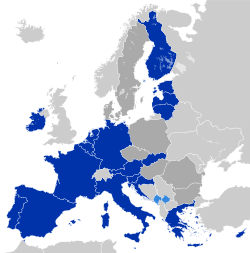Geographical scope
- EU data
Currently, and since Brexit on February the first 2020, Eurostat data are aggregated at the EU-27 level, known as EU-27. [11] [12] Before Brexit Eurostat data was aggregated at the EU-28 level, known as EU-28.
Since Brexit occurred on February the first 2020, data has to be computed for the EU-27 because by definition Brexit makes the UK a third country to the EU.
Nonetheless, to avoid confusion with the previous EU-27 group of 27 member states — which was used in the series of statistical data before the accession of member state number 28 — another name for the current EU 27 without the UK is defined as EU27_2019 in February 2019 and EU27_2020 since March 2020 according to Eurostat. [12] [13]
The name changed from EU27_2019 to EU27_2020 due to a British constitutional delay which resulted in Brexit being delivered in 2020 rather than the initially planned 2019.
The concept of the EU 28 has been used since 1 January 2014, also according to the Eurostat methodological manual on city statistics, 2017 edition.
Local data are also computed at the NUTS level.
- Statistical cooperation in and around Europe
Eurostat is also engaged in cooperation with third countries through the European Statistical System, Enlargement Policy, and European Neighbourhood Policy. [14]
In 2021, European Statistical System includes 4 EFTA countries, that is 3 EEA countries and Switzerland. [15]
EU Enlargement Policy includes "candidate countries" in the process of joining the EU and other potential candidates. [15]
In 2021, European Neighbourhood Policy covers 16 countries such as 6 ENP-East countries — Armenia, Azerbaijan, Belarus, Georgia, Moldova and Ukraine — and 10 ENP-South countries — Algeria, Egypt, Israel, Jordan, Lebanon, Libya, Morocco, Palestine, Syria and Tunisia. [15]
The trade and cooperation agreement between the European Union and the United Kingdom — since 1 January 2021 — includes a provision on statistical cooperation that foresees the establishment of a specific future arrangement. [15]







